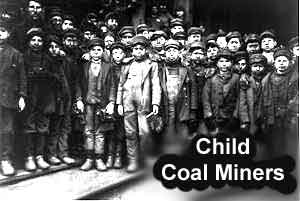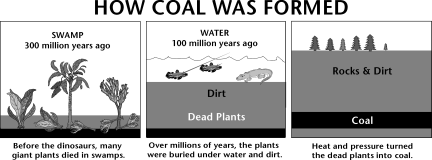Coal Mine
Historical Testimonies
The advent of the
steam engine that allowed for more efficient coal mining soon created a
positive feed back engine that demanded more and more coal.
Today coal is used for energy production and production of synthetics.
> coal is a fossil
fuel
that was produced in the Carboniferous and is made of carbonaceous
material
> coal is used to produce half of the electrical energy in N.A.

> coal is a black sedimentary rock
composed of carbon
> coal is sometimes called solid sunshine

> all of the energy released from coal was first harnessed by
photosynthesis in plants about 300 million years ago some coal beds are
only 1 million years old
> when plant debris is produced faster than it is decomposed a peat bed is
formed (low O2 environment)
> during subsequent geological eras sediments are laid over this peat and
heat and pressure transform it into coal
> the world has several hundreds of
years of coal left
> burning coal releases CO2 SO2 NOx's
> SO2 converts to sulfuric acid and falls as acid rain
> NOx's smog (photo chemically induced air pollution)
> modern N.A. coal plants have scrubbers that remove SO2 but
this increases the CO2 (global warming)
> China has massive amounts of coal and use it for energy while producing
massive air pollution
> Eastern Coal has a greater sulfur
content than western coal
> Ontario burns coal at the Lakeview
generator in Mississauga and Nanticoke on Lake Erie both are serious
sources of air pollution especially when the atmosphere has an inversion
in the summer

Anthracite
|
highest
carbon content, between 86 and 98 percent, and a heat value of
nearly 15,000 BTUs-per-pound. Most frequently associated with home
heating, |
|
Bituminous |
The most
plentiful form of coal in the NA, used primarily to generate
electricity and make coke for the steel industry. has a carbon
content ranging from 45 to 86 percent carbon and a heat value of
10,500 to 15,500 BTUs-per-pound. |
|
Lignite |
Lignite is a
geologically young coal which has the lowest carbon content, 25-35
percent, and a heat value ranging between 4,000 and 8,300
BTUs-per-pound. Sometimes called brown coal, it is mainly used for
electric power generation. |
|



